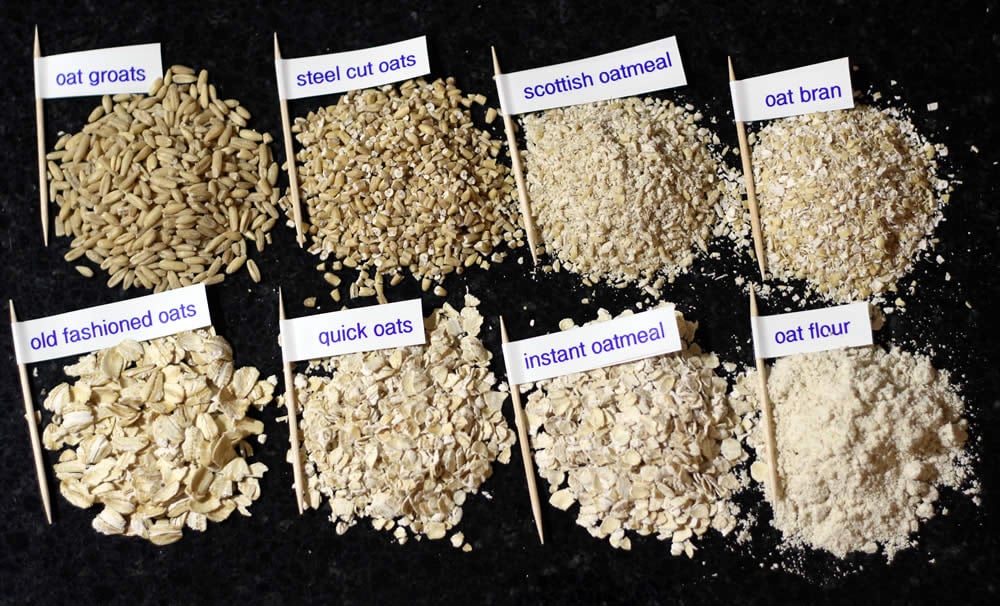The Types of Oatmeal
Oct 05, 2012, Updated Oct 14, 2017
Groats. It’s a funny word. Could be a grumpy goat or a healthy whole grain. Since this post is part of October Unprocessed and I’m a nutrition nerd, odds are it’s the latter. (Actually, I’m also an animal-loving nerd, so really, it’s a crap shoot.)
I’m sure you’ve heard that you should eat less processed foods. Heck, as a dietitian, I’ve been doling out that advice for ten years. But, it’s kind of a confusing concept. At the most basic level, any change intentionally made to a food before it winds up on our taste buds counts as processing. It can range from dehydrating fruits to hydrogenating fats and the different types of processing can be straightforward or complex. Unless you’re living sustainably and exclusively from your own grain field, vegetable garden, and fruit trees, the truth is that you’re probably consuming processed foods. Join the club.
What does processing really look like? Let’s take oats as a case in point. If you’re a visual learner, please consider the photo at the top of this post. See if you can tell the difference between the many piles of oaty goodness. (I’ll explain more about the piles in a minute…)
One of the most memorable quotes from the movie Super Size Me is this: “It is a matter of common knowledge that any processing that foods undergo serves to make them more harmful than unprocessed foods.” As a general rule, the more we mess with it, the worse it is for us. So why do we do it? Reasons for processing can be to improve taste, shorten preparation time, or increase shelf life, so it’s not all done with bad intentions.
Oats are a perfect example of a food available in the marketplace that’s gone through varying levels of mechanical processing. They’re also a picture-perfect example of a healthy food, as their heartiness seems to be especially satiating in our bellies and their fiber seems to lower cholesterol in our blood. (In a country where the two-thirds of us are overweight and the leading cause of death is heart disease, that’s no small feat.)
One of the most common reasons oats and other foods are processed in the first place is to reduce cooking time. Oat groats take 60 minutes to cook while instant oatmeal is ready in 60 seconds. Nutritionally speaking, all the options pictured are considered whole grains, but the closer you get to the groat end of the spectrum, the better (good advice for all areas of life, I think). If you’re not ready to dedicate an hour to your breakfast cereal, aim for the other oat options that are minimally processed. We use the brown rice setting on our rice cooker to make groats in the evening (while we watch Mythbusters or Wipeout or something else educational), and we’ve a got healthy breakfast for the whole week that can be reheated in the same time it takes to make the instant stuff. Check out my recipes for Cherry Maple Granola or Coconut Mango Barley Breakfast (just substitute cooked oat groats for the barley in this one) if you want to get a little grainy this month.
Here are the types of oats shown in the picture above:
Oat groats: as whole grainy as you can get where oats are concerned. Unadulterated. Only the inedible hull has been removed. Cooks in 50-60 minutes.
Steel cut oats: also called Irish oats or pinhead oats, these are just groats that have been cut into smaller pieces to speed cooking. Cook in 10-20 minutes.
Scottish oatmeal: another version of groats that have been broken into bits, only these are stone ground instead of being cut. Cooks in 10 minutes.
Oat bran: a high-fiber part of the oat that’s been removed and can be eaten separately. Oat bran can be prepared as its own hot cereal or simply sprinkled on your favorite bowl of breakfast to boost the nutrient content of every bite. Cooks in 2 minutes.
Old fashioned oats: groats that are steamed and then pressed flat. Increasing the surface area this way and partially cooking them helps you get breakfast to your mouth faster. Cooks in 5 minutes.
Quick oats: like old-fashioned oats, except rolled thinner and steamed longer. Cook in 1 minute.
Instant oatmeal: like quick oats, except rolled even thinner and steamed even longer. Cooks in 1 minute. (This is the only product on this list that has been processed in an additional way – it’s had stuff added to it before packaging. In the case of the “original” or plain flavor, pictured here, salt, color, vitamins and minerals have been mixed with the oat flakes. The popular flavored packets have all that, plus added sugar, which bumps up the calories.)
Oat flour: pulverized groats that can be used in baking, etc. This is still considered a whole grain because nothing was removed before the oats were ground into flour.
Remember, it’s all relative. It doesn’t have to be all whole grains all the time. If you’re currently eating quick oats, go one step to the left on the spectrum for October Unprocessed. Chances are you’ll be amazed and delighted by the change in texture and you’ll have yourself a new favorite breakfast. And if you go all the way to the groats, you’ll have a new favorite word.





















Thanks for the info! Here’s something else you can do to oats to make them more digestible– FERMENT THEM! Here is a recipe/technique.
http://fermentersclub.com/porridge
Cool! Something new to try with oats. Thanks for the tip.
You’re welcome. One other thing to mention is that after soaking/fermenting, the steel cut oats only take 5 minutes to cook!
Thanks for the post! I like to make steel cut oats in my slow cooker on a Sunday night, with dried fruits added, plus a little cream. It comes out perfect for Monday AM. Groats must come out pretty well in the same way. I’d like to give it a try!
So you put the dried fruit in while it’s cooking? That’s a great idea. It would really cut down on prep time Monday morning – you’d be ready to eat in a jiffy!
Started eating steel cut oats last month with project healthy with DJ Waldow, LOVE them! You can do the night before to save time. Love the idea of using my brown rice cooker!
Thanks!
Thanks for taking the time to comment, Mary. It is so convenient to make them ahead so they’re ready to go in the morning.
I eat oatmeal nearly every day. My usual method is old fashioned oats with a tablespoon of ground flax and a tablespoon of raw sunflower seeds added. I just add really hot water and let it sit for a minute or two. I add a drizzle of local honey for my allergies. Yum! My new favorite way to eat oats is the pancake recipe I found here at Eating Rules. Here’s the link: http://www.eatingrules.com/2010/05/healthy-pancakes-that-taste-good/
That’s another great way to include this healthy food, especially for kids or other folks who might not enjoy a bowl of oatmeal. Pretty much everyone likes pancakes!
Love this post! I always wondered what the differences were. I currently eat old fashioned oats daily for breakfast, but I’ve made steel-cut oats in the past. I’ll have to break out the slow cooker to make that more often!
The slow cooker is a good idea. So much easier to just turn it on and forget about it until it’s done!
I make Scottish oatmeal in England (my Scottish friends use medium oatmeal). My American friends love it when I serve it to them, but can’t find it in the States. Do you know where you can buy it there?
Bob’s Red Mill sells Scottish oats – you can find his products at most regular grocery stores and definitely at natural foods markets. Here’s a link to it: http://www.bobsredmill.com/organic-scottish-oatmeal.html
How exciting! I’ve emailed the link to one of my friends and I’ll look for it myself when I visit my sister in LA. Thanks so much.
Good Post ! I switched to steel cut a few years back and love it. Cook a larger pot & freeze extra portions. I may try the oat groats next ans see how it tastes. Me liking it is one thing & getting my family to buy in another 🙂 Thanks for sharing !
That’s a great suggestion. I’ve never tried freezing the extras. So handy.
Thanks for the information! I have Steel Cut in the house, but I don’t like the texture, so I eat Old Fashioned most mornings.
Hi Jacqui. Texture is definitely an issue for me, too. That’s why I like the groats so much – very chewy and delicious.
I’ve never even heard of groats! I have heard of Irish & Scottish but I thought they were the same as old-fashioned. Who knew? 🙂
Hi Brista. I know, most of us grow up with the familiar flat old-fashioned oat flakes in our cupboard. Hard to imagine that’s not how they started out.
Super interesting! Who knew there was such a difference between them all. I typically go with the old fashioned oats simply as a time factor in the morning. But I think for October I’m going to try to take the extra time and go with the Steel Cut!
Hi Andrea. So cool that you’re going to try something new in the world of oats. Hope the steel cuts make you happy!